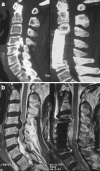Anterior corpectomy and fusion for severe ossification of posterior longitudinal ligament in the cervical spine
- PMID: 18408927
- PMCID: PMC2899051
- DOI: 10.1007/s00264-008-0542-y
Anterior corpectomy and fusion for severe ossification of posterior longitudinal ligament in the cervical spine
Abstract
Between May 2002 and October 2006, 19 patients (17 men and 2 women; average age 57.2; range 47-71 years) received anterior corpectomy and fusion for severe ossification of the posterior longitudinal ligament (OPLL) in our department. Preoperative radiological evaluation showed the narrowing by the OPLL exceeded 50% in all cases, and OPLL extended from one to three vertebrae. We followed-up all patients for 12-36 months (mean 18 months). The Japanese Orthopaedic Association (JOA) score before surgery was 9.3 +/- 1.8 (range 5-12) which significantly increased to 14.2 +/- 1.3 (range 11-16) points at the last follow-up (P < 0.01). The improvement rate (IR) of neurological function ranged from 22.2-87.5%, with a mean of 63.2% +/- 15.2%. The operation also provided a significant increase in the cervical lordosis and the cord flatting rate (P < 0.01). No severe neurological complication developed. We therefore concluded that anterior decompression and fusion was effective and safe in the treatment of the selected patients, although OPLL exceeded 50% diameter of the spinal canal.
Entre mai 2002 et octobre 2006, 19 patients (17 hommes et 2 femmes) âgés en moyenne de 57,2 ans (47 à 71 ans) ont bénéficié d’une corporectomie antérieure avec arthrodèse pour une ossification sévère postérieure du ligament (OPLL). L’évaluation radiologique préopératoire a montré que l’importance de l’ossification était supérieure à 50% dans tous les cas et cette ossification (OPLL) s’étendait sur 1 à 3 niveaux vertébraux. Tous les patients ont été suivis en moyenne de 12 à 36 mois (18 mois en moyenne). Le score de la JOA a été de 1,8 en préopératoire (5 à 12) et a progressé jusqu’à 9,3 à 14,2 (11 à 16) au dernier suivi (P < 0,01). Le pourcentage d’amélioration neurologique a été de 22,2% à 87,5% avec une moyenne de 63,2%. L’intervention entraîne également une amélioration significative de la lordose cervicale et du taux d’applatissement de la moelle (P < 0,01). Aucune complication neurologique sévère n’a été observée. Nous pouvons conclure que la décompression antérieure associée à une greffe est une technique efficace et sûre du traitement des OPLL chez les patients sélectionnés dont le diamètre du canal rachidien doit être supérieur à 50%.
Figures


References
-
- Choi S, Lee SH, Lee JY, et al. Factors affecting prognosis of patients who underwent corpectomy and fusion for treatment of cervical ossification of the posterior longitudinal ligament: analysis of 47 patients. J Spinal Disord Tech. 2005;18:309–314. doi: 10.1097/01.bsd.0000161236.94894.fc. - DOI - PubMed
-
- Chiang HS, Kondo S, Mizuno J, et al. Airway obstruction caused by cerebrospinal fluid leakage after anterior cervical spine surgery. A report of two cases. J Bone Joint Surg (Am) 2004;86:370–372. - PubMed
-
- Dorai Z, Morgan H, Coimbra C. Titanium cage reconstruction after cervical corpectomy. J Neurosurg. 2003;24:3–7. - PubMed
Publication types
MeSH terms
LinkOut - more resources
Full Text Sources
Medical

